Key findings
- Several species of groundnesting birds including waders, red grouse and hen harriers declined following the cessation of game keepering.
- Cessation of predator control by gamekeepers was associated with more carrion crows and probably more foxes.
- Moorland passerines, chiefly meadow pipits and skylarks were fewer when there were more hen harriers. These observations together with studies of prey brought to harrier chicks suggested that harriers may negatively impact upon their preferred prey.
The relationship between hen harriers and red grouse is highly contentious. Predation by harriers can limit grouse productivity, reduce shooting bags and ultimately can lead to the loss of grouse shooting and management. This was clearly shown to be the case on Langholm Moor during the Joint Raptor Study (1992-1997). In addition, there has been a lot of speculation about changes in the number of other moorland birds at Langholm Moor in relation to hen harriers.
With recent support from Scottish Natural Heritage, we have been counting numbers of breeding ground-nesting birds within 15 sample 1x1 kilometre squares at Langholm. To do this, we have adopted a standard transect technique used by the British Trust for Ornithology’s Breeding Bird Survey. We recorded all birds seen from two parallel one kilometre transects situated 500 metres apart within the grid square. We wanted to find out whether bird abundance changed during two periods of the study. First, between 1992 and 1997 when numbers of breeding hen harriers increased from two breeding females in 1992 to 20 in 1997 and, second, after grouse management ceased in 1999.
In all, we observed 50 bird species, but there were only sufficient data for analysis of 10. Of these, estimates of numbers of golden plover, skylark and meadow pipit differed between observers, whereas estimates of red grouse abundance differed between dates of survey, with more birds being seen earlier in the season. Numbers of golden plover, lapwing, curlew and red grouse declined over time, whereas those of carrion crow and snipe increased (see Figure 1). Hen harrier numbers increased then declined. Lapwing abundance was higher during the first, period but lower during the second. Moorland passerines (skylark, meadow pipit and stonechat) tended to be lower when harrier numbers were highest. Watches at harrier nests even suggest that predation by harriers on pipits may be important.
Figure 1: Trends in abundance of 10 bird species at Langholm Moor, 1992-2006
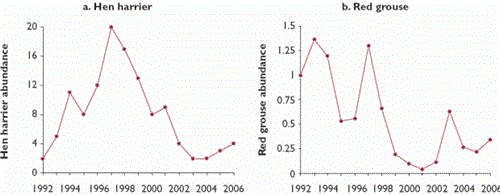
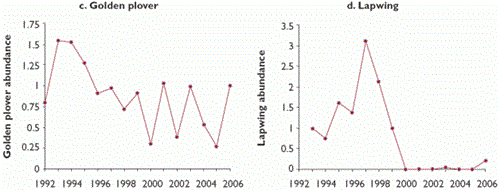
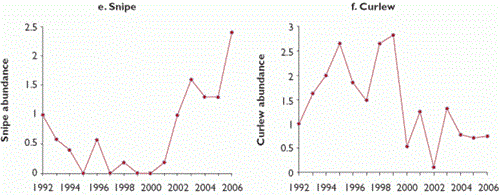
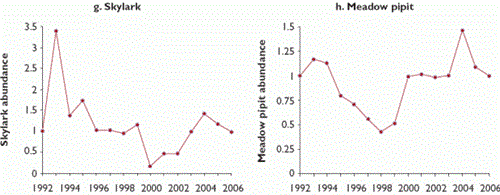
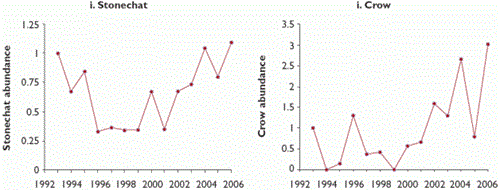
Data for hen harriers are the number of breeding females.
Numbers of golden plover, curlew, red grouse, skylark and hen harrier were all two to three times higher during the first half of the study when the moor was managed for grouse, than during the second half when management had ceased (see Table 1). Lapwings were virtually lost from our count areas after grouse management stopped. In contrast, numbers of carrion crows increased four-fold when gamekeeping, including crow control, stopped. This increase in predators like crows, as well as probably foxes, could have contributed to the declines in other bird populations, although other factors such as reduced habitat quality and variation in counts between different observers over time cannot be entirely ruled out.
Table 1: Differences in bird species abundance (mean birds per kilometre) when gamekeepers were present (1992-1999) and absent (2000-2006)
| Species |
Gamekeeper present |
Gamekeeper absent |
| Hen harrier |
11 |
5* |
| Red grouse |
0.74 |
0.28** |
| Golden plover |
0.38 |
0.21* |
| Lapwing |
0.38 |
0.01* |
| Snipe |
0.06 |
0.18* |
| Curlew |
1.77 |
0.71* |
| Skylark |
5.40 |
2.30** |
| Meadow pipit |
17.20 |
19.8 |
| Stonechat |
0.22 |
0.31 |
| Carrion crow |
0.10 |
0.44* |
Notes: Hen harriers = breeding females on the whole moor (n=15 years). *P<0.05, **P<0.01, ***P<0.001. 2001 was used as the year that keepering stopped as carrion crow exhibited a one-year lag in recovering after being systematically trapped before 2000.
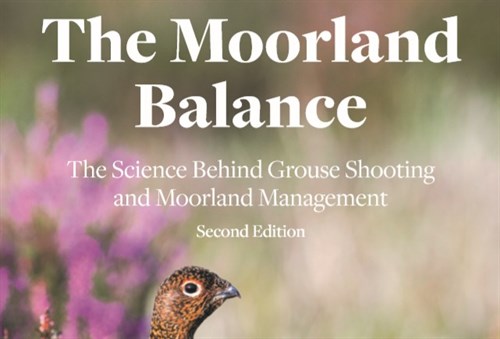
The Moorland Balance - eBook - only £4.99
Get the science behind grouse shooting and moorland management. Building on the success of the first edition, this new and improved version condenses thousands of pages of scientific literature into easy-to-read questions and answers. Over 200 different studies from across the scientific community are referenced in this 134-page book.
View Book >
or
Buy Now - £4.99 >
100% Secure. All Credit & Debit cards, PayPal, Apple Pay and Google Pay accepted.
